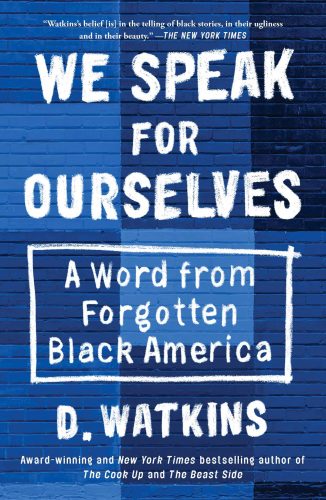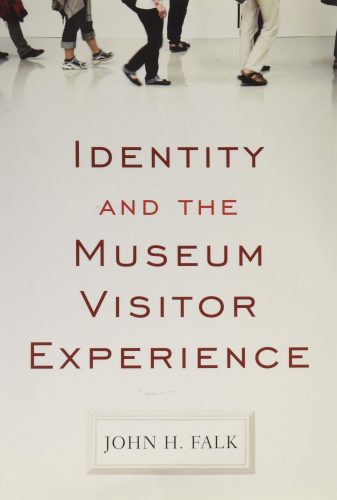Representation Matters

A blog post by Deputy Director Tracie Guy-Decker. Read more posts from Tracie by clicking HERE.
What D. Watkins helped me understand about museums
I am often working my way through more than one book at a time. Especially right now in the midst of quarantine, I have been turning to the page as my way out of the house. While I was reading D. Watkins’ We Speak for Ourselves: A Word from Forgotten Black America, I have also been making my way through Identity and the Museum Visitor Experience by John H Falk.

I have written about Watkins before. A fellow Baltimorean, I’ve been following his career not-quite from the beginning. In my mind, what sticks out about D. Watkins is his authenticity. He makes me believe he knows who he is and is sharing that person–without pretense or posturing–on the page.
When I wrote about him three years ago, I was struck by “Watkins’ ability to introduce us to characters with seemingly perfect empathy. His descriptions of the people who inhabit his world paint pictures of fully human individuals. This is remarkable because the humanity of the people he depicts is so consistently denied in most of the media that those of us in the room usually consume. Drug dealers and addicts, prostitutes and felons, all receive their full humanity from D. Watkins’ pen. His empathy for them is contagious.”
Though my use of the word “contagious” sticks out as I re-read it from quarantine, I find the persuasive force of Watkins’ empathy, and, more importantly, his affection for the friends and acquaintances he introduces us to, remains in full force in this latest work. I feel I am a slightly better person for having allowed myself to be carried along by the affection for the full humanity of characters like Big Wop, Dub, Turk, and O.G.
As with my reading of Lawrence Lanahan, it is an interesting experience to read another’s recollections and interpretations of moments I lived through. I read Watkins’ essays on the Uprising and the schande of Baltimore’s Gun Trace Task Force with a speed and an emotional and physiological reaction I can only describe as validating. (As an aside, as I read this book, I began to wonder about the experience of Watkins’ and Lanahan’s readers from outside of Baltimore. It is hard for me to imagine the experience of reading about the Uprising and after without my prior knowledge of it.)
But the connection Watkins’ work made for me in 2020 actually had to do with his description of how addictive and positive reading can be–when you start with the right material. In an essay near the end of We Speak for Ourselves, Watkins writes about finding reading. While in the hospital, a nurse loaned him The Coldest Winter Ever by Sister Souljah. He writes: “I read it in under two days. She was right. It was the fastest I’d ever read a book in my life. Who knew you could write books about the streets? I would’ve read this book ten times if it was assigned to me in high school.
The Coldest Winter Ever opened up my mind and led me to consume more and more books. My thoughts changed. I developed new ideas. I was forever transformed. Within months I went from being a guy who solved problems by breaking a bottle over someone’s forehead to using solution-based thinking when resolving issues. It was as if reading instantly civilized me. It also made me acknowledge the need for culturally relevant material. Familiar information is less intimidating. And if it worked for me, I believe it can work for anybody.” (pp 156 – 157)
The memory of this experience led Watkins to work to get his own writing into the hands of Baltimore’s students. Through grants and his own money, Watkins donated copies of his books to city schools in Baltimore and Washington, DC. “The deal was for me to make classroom visits and teach workshops to every class that received the books and the students would get to keep the books because they were being stolen from schools.” (p 162)
Watkins goes on to relay how despite successful outcomes in the classrooms he visited, in 2017 he learned from one of the classroom teachers who’d been using Watkins’ titles “they passed on your book…They decided to double down on Shakespeare.” (p 163)

Falk is among the researchers who have found that one of the most predictive behaviors of museum visitation is museum visitation (in other words, the likelihood of you visiting any given museum in the next 6 to 12 months is highly correlated to whether or not you have visited any other museum in the past 6 to 12 months). Further, adults who visit museums are likely to have visited as children. I was thinking about those statistics and about the session I attended at the American Alliance of Museums conference last year where I heard that at the National Museum of African American History and Culture (NMAAHC), from day one, they were seeing dwell times (i.e. the length of a museum visit) that doubled and even tripled the industry average (6 hours at NMAAHC vs. 1.75 – 2 hours for the national average). I haven’t seen the data, but I wonder how many of those long-dwelling visitors to the NMAAHC are visiting their first museum in the past 12 or 24 months, or longer?
In Identity and the Museum Visitor, Falk is more interested in what he calls “small i” identity than in big I identity. In other words, he’s looking at whether a person thinks of themselves as curious or spiritual or a good parent rather than whether they are black or white or Asian or how old they are or their gender identity. Falk makes a compelling case, and has the data to back it up. In fact, Falk conducted a study of African American museum-going. Of it, he writes: “The overwhelming conclusion of my research was that, overall, African American leisure behavior was very similar to European American leisure behavior, while tremendous differences existed within and across the African American community. Where black-white differences existed, race/ethnicity did not emerge as the best variable to explain these differences.” (p 29)
I believe Falk’s data did suggest those outcomes. I also know the study was done in 1993, more than two decades before the NMAAHC was a reality. I wonder what a study of African American NMAAHC visitors would find. More than that, I would like to know of the visitors to NMAAHC who were infrequent museum goers prior to their visit, how many visited another museum in the following 6 to 12 months? Can NMAAHC or the Reginald Lewis Museum in Baltimore or other African American museums or other heritage museums around the country do for a museum visitor what The Coldest Winter Ever did for D Watkins, the reader?
I can’t help but think the answer is ‘yes.’ I read this passage from Watkins, and translate it from ‘reading’ to ‘visiting museums,’ and it rings true for me:
“‘Reading is boring’ is a phrase I’ve been hearing at the beginning of each semester ever since I became an adjunct professor. I give them my soliloquy on why it was illegal for slaves to read and how easy it was for masters to control populations of people wiht limited thoughts–partially due to illiteracy. I would say, ‘Being smart and developing complex thoughts without reading is like trying to get The Rock’s muscles without working out.’
Then I assign cool books like Sister Souljah’s The Coldest Winter Ever, Jay-Z’s Decoded, Liza Jessie Peterson’s All Day, Jason Reynold’s Long Way Down, and essays by me and other writers I think they would like. I also scour the internet for articles that speak directly to them. I believe that everyone would enjoy reading if they had the right material. Obtaining material that speaks to them would not only provide the foundation for the basic critical thinking skills needed to function, but also spark a greater interest in literature outside the classroom.” (p155)
Right now, we are all starting to more fully grasp the exponential effect we can have as our lives intersect with others’. Luckily for human beings, COVID-19 isn’t the only thing that can spread exponentially. Reading, history, knowledge, skills, self-compassion and self-esteem can also be caught and passed on. That’s part of what I got out of Watkins’ continued return to the first book that showed him a different way.
We Speak for Ourselves is a collection of essays. I wouldn’t say that there is a central hypothesis, but there are certainly recurring themes. As you might expect from the title, one of them is that black folks have voices to speak for themselves, if they were ever given the chance. Watkins repeatedly declines that he is “the voice” of his people, insisting instead he is “a voice.”
It is a voice worth reading: clear, authentic, likable, insightful. One of the insights, for me, from this voice, is the power of people–especially young people–hearing voices they recognize as like their own speak from positions of perceived power and authority. In other words, representation matters. I am sure that John Falk is right that little i identities are more predictive of museum-goers’ meaning-making than big I identities. I’m also sure that if the big I identities of the visitor (or reader or viewer) are ignored, neglected, or, worse, denigrated, by a museum (or book or show) the lasting effect is hurt to us all.
This post was originally published at bmoreincremental.com.
